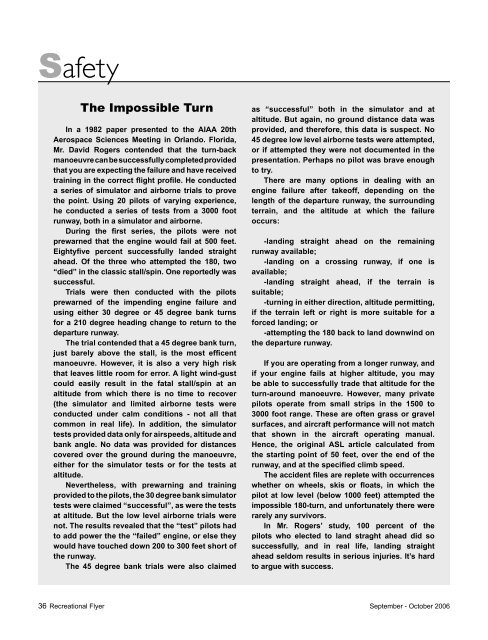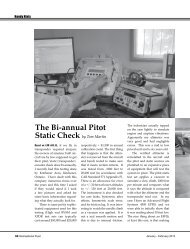September - October - The Recreational Aircraft Association
September - October - The Recreational Aircraft Association
September - October - The Recreational Aircraft Association
You also want an ePaper? Increase the reach of your titles
YUMPU automatically turns print PDFs into web optimized ePapers that Google loves.
Safety<br />
<strong>The</strong> Impossible Turn<br />
In a 1982 paper presented to the AIAA 20th<br />
Aerospace Sciences Meeting in Orlando. Florida,<br />
Mr. David Rogers contended that the turn-back<br />
manoeuvre can be successfully completed provided<br />
that you are expecting the failure and have received<br />
training in the correct flight profile. He conducted<br />
a series of simulator and airborne trials to prove<br />
the point. Using 20 pilots of varying experience,<br />
he conducted a series of tests from a 3000 foot<br />
runway, both in a simulator and airborne.<br />
During the first series, the pilots were not<br />
prewarned that the engine would fail at 500 feet.<br />
Eightyfive percent successfully landed straight<br />
ahead. Of the three who attempted the 180, two<br />
“died” in the classic stall/spin. One reportedly was<br />
successful.<br />
Trials were then conducted with the pilots<br />
prewarned of the impending engine failure and<br />
using either 30 degree or 45 degree bank turns<br />
for a 210 degree heading change to return to the<br />
departure runway.<br />
<strong>The</strong> trial contended that a 45 degree bank turn,<br />
just barely above the stall, is the most efficent<br />
manoeuvre. However, it is also a very high risk<br />
that leaves little room for error. A light wind-gust<br />
could easily result in the fatal stall/spin at an<br />
altitude from which there is no time to recover<br />
(the simulator and limited airborne tests were<br />
conducted under calm conditions - not all that<br />
common in real life). In addition, the simulator<br />
tests provided data only for airspeeds, altitude and<br />
bank angle. No data was provided for distances<br />
covered over the ground during the manoeuvre,<br />
either for the simulator tests or for the tests at<br />
altitude.<br />
Nevertheless, with prewarning and training<br />
provided to the pilots, the 30 degree bank simulator<br />
tests were claimed “successful”, as were the tests<br />
at altitude. But the low level airborne trials were<br />
not. <strong>The</strong> results revealed that the “test” pilots had<br />
to add power the the “failed” engine, or else they<br />
would have touched down 200 to 300 feet short of<br />
the runway.<br />
<strong>The</strong> 45 degree bank trials were also claimed<br />
as “successful” both in the simulator and at<br />
altitude. But again, no ground distance data was<br />
provided, and therefore, this data is suspect. No<br />
45 degree low level airborne tests were attempted,<br />
or if attempted they were not documented in the<br />
presentation. Perhaps no pilot was brave enough<br />
to try.<br />
<strong>The</strong>re are many options in dealing with an<br />
engine failure after takeoff, depending on the<br />
length of the departure runway, the surrounding<br />
terrain, and the altitude at which the failure<br />
occurs:<br />
-landing straight ahead on the remaining<br />
runway available;<br />
-landing on a crossing runway, if one is<br />
available;<br />
-landing straight ahead, if the terrain is<br />
suitable;<br />
-turning in either direction, altitude permitting,<br />
if the terrain left or right is more suitable for a<br />
forced landing; or<br />
-attempting the 180 back to land downwind on<br />
the departure runway.<br />
If you are operating from a longer runway, and<br />
if your engine fails at higher altitude, you may<br />
be able to successfully trade that altitude for the<br />
turn-around manoeuvre. However, many private<br />
pilots operate from small strips in the 1500 to<br />
3000 foot range. <strong>The</strong>se are often grass or gravel<br />
surfaces, and aircraft performance will not match<br />
that shown in the aircraft operating manual.<br />
Hence, the original ASL article calculated from<br />
the starting point of 50 feet, over the end of the<br />
runway, and at the specified climb speed.<br />
<strong>The</strong> accident files are replete with occurrences<br />
whether on wheels, skis or floats, in which the<br />
pilot at low level (below 1000 feet) attempted the<br />
impossible 180-turn, and unfortunately there were<br />
rarely any survivors.<br />
In Mr. Rogers’ study, 100 percent of the<br />
pilots who elected to land straght ahead did so<br />
successfully, and in real life, landing straight<br />
ahead seldom results in serious injuries. It’s hard<br />
to argue with success.<br />
36 <strong>Recreational</strong> Flyer <strong>September</strong> - <strong>October</strong> 2006




